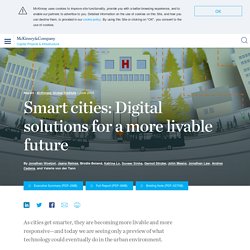

How to Drive a Digital Transformation. Inside the Digital Factory. The industrial world has been in the throes of digitization for well over a decade. Primarily through enterprise resource planning (ERP) and manufacturing execution systems (MES), critical planning, scheduling, warehousing, inventory management, and logistics processes have been automated and simplified. But these gains have been restricted to technology silos, supporting separate functions of the factory rather than improving the performance of the plant — and its extended supply chain — in a broader way. Those days may finally be in the past, as manufacturers now have a golden opportunity to take advantage of digitization’s promised outsized benefits.
The advent of complex smart sensors, artificial intelligence, big data pools, and robotics, combined with the vast connections of the cloud, is heralding a new era for manufacturers, marked by totally integrated factories that can rapidly tailor products to individual customer needs and respond instantly to shifting demands and trends. Is the Right Group Leading Your Digital Initiatives? Companies shouldn’t bottle up digital transformation in any one function.

Recent research on digital transformation has revealed how companies — particularly large legacy ones — are seeking to adapt to an increasingly digital world. For our most recent study, we asked managers, executives, and analysts, “Which functional area is primarily leading your company’s digital progress?” How to Balance Digital Expertise and Sustainability. Digital Technology and Sustainability: Positive Mutual Reinforcement.
Digital Champions. Embracing the reality of digital transformation. Digital disruption has broken out of Silicon Valley.

Any company, no matter how nuts-and-bolts, can be disrupted by a digital competitor; equally, any company could be that digital disruptor. With the threats and opportunities ever greater, CDW organised an executive roundtable in London in May with the theme “Embrace disruption. Embrace transformation”. The discussion was kick-started by two leading industry thinkers: Andrew Moore, chief transformation officer of chipmaking giant Intel, and Nigel Moulton, chief technology officer at Dell EMC, part of a corporation that services 99% of the Fortune 500 companies.
5 Tips to Better Train Executives on Digital Transformation. The Evolved Enterprise: Unlocking Growth Through Digital Transformation. Digital Transformation: A Modern Form Of Creative Destruction. Business is not Getting Better at Digital Transformation, says Capgemini. Smart cities: Digital solutions for a more livable future. As cities get smarter, they are becoming more livable and more responsive—and today we are seeing only a preview of what technology could eventually do in the urban environment.

Until recently, city leaders thought of smart technologies primarily as tools for becoming more efficient behind the scenes. Now technology is being injected more directly into the lives of residents. Smartphones have become the keys to the city, putting instant information about transit, traffic, health services, safety alerts, and community news into millions of hands. Video. Inside the Digital Factory. Why Chief Data Officers Should Lead Digital Transformation. 2018 BCG Global Challengers: Digital Leapfrogs. Emerging-market companies have grown faster than companies in developed markets in most industries over the past decade.

One big reason is their embrace of digital technologies. Nowhere is the trend toward digitization more evident than among the 100 companies that we call global challengers, many of which are leveraging digital technologies both to win in emerging markets and to compete globally with multinationals. Évaluation de la transformation numérique. Coming of Age Digitally: Learning, Leadership and Legacy. These shifts suggest that companies are beginning to take digital disruption more seriously and make meaningful changes in how they work.

Such shifts persist even when controlling for company age and other organizational characteristics, and may anticipate even greater changes in the years to come. It is possible that many companies have not responded to digital disruption sooner because their competitors weren’t responding, either. Now that some companies have started to move more aggressively to adapt their organization to a digital world, it may mean that others may soon follow in response. As we saw in the John Hancock example, companies may be reluctant to adapt while they are successful. If your company is not making meaningful steps to become more digitally mature, our data suggests that now may be the time to start to take action.
We might be wary of overinterpreting these trends if they weren’t backed up by anecdotal data from our interviews. Coming of Age Digitally. About the Authors: Gerald C.

Kane is the MIT Sloan Management Review guest editor for the Digital Business Initiative and a professor of information systems at the Carroll School of Management at Boston College. The Future Chief Data Officer 2018 Special Report. The Evolved Enterprise: Unlocking Growth Through Digital Transformation. Digitization: A Required Transition. Kev Coleman - May 23, 2018 Kevin Coleman is a highly skilled senior level project and program manager/advisor with experience leading projects with labor budgets ranging from a few hundred thousand dollars to multi-million dollar budgets across multiple industries.

All the world is increasingly dependent upon the little 1s and 0s that have become essential to the way we live and work. If you look back, you will see digital electronics really began in the late 1950s and saw a huge spike in the late 1970s as digital equipment began to experience widespread adoption. It continues to rapidly grow and evolve to the present day. Many say that continued movement to the 1s and 0s environment is accelerating with no slowdown in sight. Digitization is the name associated with the application of digital technology (1s and 0s) in all aspects of society including business. Building Digital Culture: A Practical Guide to Successful Digital Transformation by Daniel Rowles and Thomas Brown (2017) Quantum Underwriting: A Core Capability for Bionic Companies. The development of new technological capabilities and applications creates huge opportunities for business.

But where there is opportunity, there is also risk. There will continue to be data breaches, accidents, cyber-attacks, and infrastructure failures during the next few years — and other, hitherto unrecognized threats from newer technologies will join them. The presence of risk requires robust systems for trading on and underwriting that risk. For that reason, the underwriting of technological change will soon become one of the core competencies that companies must develop or acquire to compete in the bionic age — an age in which companies will succeed based on their ability to leverage financial, human, natural, behavior, cognitive, and network capital.
You could call this type of risk management quantum underwriting, as it is intimately associated with quantum-style probability metrics. It’s Not a Digital Transformation Without a Digital Culture. Signaling change with symbolic acts that embody the new culture is a good way to activate leadership characteristics quickly.

For example, companies can designate meeting-free days to emphasize greater focus on action over planning, or they can give engineers a cash allowance to buy their own desktop equipment to demonstrate trust. Sometimes even a bold move, such as firing people whose behavior is antithetical to the new culture, is warranted.
To signal change at Cisco, executives in certain divisions gave up their offices so the company could create team rooms; the company also started allowing employees to choose the workspace and tech tools that best fit their individual roles. The CEO of the North American software provider cited earlier began sending notes to employees who are praised by name in customer reviews. Such acknowledgment serves as an example of how company leaders can reinforce the customer-first mindset that’s central to the company culture. 75% des entreprises canadiennes sont en cours de transformation numérique. Et vous?
Les entreprises désinvestissent pour tirer parti du numérique. «Les entreprises canadiennes se tournent plus que jamais vers le désinvestissement pour obtenir un avantage concurrentiel», affirme Fany Boucher, associée, Soutien à la transaction chez EY.

Les 7 clés d'une transformation numérique réussie. Digital sustainability and the journey - Korn Ferry Focus. Four Business Models for the Digital Age. Digitization, which is of course happening all around us, is opening up a whole new spectrum of opportunities to create value. But how do you navigate this new horizontal world? Peter Weill and Stephanie Woerner offer some useful insights on these challenges in their 2015 Sloan Management Review article, “Thriving in an Increasingly Digital Ecosystem.” In exploring these insights, and some of their implications, leaders can gain a fuller understanding of the landscape they face. Opportunities for companies in every industry are occurring on two critical dimensions: knowledge of the end customer and business design, i.e., breadth of product and service offerings.
These dimensions combine to form four business models for creating value (see exhibit): Suppliers, Multichannel Businesses, Modular Producers, and Ecosystem Drivers. If you are a Supplier, you need to make sure your operations are as efficient as possible, but that’s only the first step. Transformation numérique: un marché qui explose. Le marché du conseil en transformation numérique pour les entreprises, que se disputent entreprises de services du numérique (ESN), agences de communication numérique et cabinets de conseil, progressera en moyenne de 22% par an d'ici à 2021, selon une étude du cabinet IDC. Digital complacency remains a big problem says Telsyte. BAIN BRIEF Organizing for a Digital World. Five Fifty: The T-word. Do You Have the Will for Digital Transformation? Successful digital transformation requires boldness and action, not secret knowledge. The ancient Greeks developed a philosophical concept called gnosis, which referred to a secret knowledge that allowed its possessors to achieve enlightenment.
This secret knowledge was possessed only by a select few, who occupied a privileged position above those who did not possess it. Are You Taking the Wrong Approach to Digital Transformation? Successful digital transformation is most often accomplished by developing a collaborative culture. In our 2017 report on digital business, we asked respondents how their companies were driving digital transformation. The report groups companies into three different stages of digital maturity — early, developing, and maturing — and we found that each has a different approach to leading digital change.
While the distinctions between how early and developing companies approach digital transformation are nuanced, the difference between these less advanced organizations and the companies that have advanced the farthest toward digital maturity is far more striking. Early and developing companies push digital transformation through managerial directive or by technology provision. In contrast, maturing companies tend to pull digital transformation by cultivating the conditions that are ripe for transformation to occur. Mandate From Management “He’ll sit here, and he’ll say, ‘Do this! Improving Your Digital Intelligence.
Fundamentally transforming your business to become fully digital isn’t easy, but focusing on increasing your digital intelligence in specific areas significantly increases the chances your digital transformation will succeed. MIT SMR Frontiers This article is part of an MIT SMR initiative exploring how technology is reshaping the practice of management. Today, virtually all companies are aware of the necessity to engage in digital transformation — and the few companies that have not done so are suffering heavily. New digital entrants, and aggressive plays by traditional competitors in reaction to those entrants, are destabilizing many industries, on average cutting by half the revenue and profit growth of standstill companies.1. Spécial transformation numérique: les 7 étapes - Les Affaires. Les technologies numériques poussent les entreprises à constamment s’adapter et se réinventer.
Un audit pour mesurer la maturité numérique d'une entreprise. Dominique Anglade, ministre de l’Économie, de la Science et de l’Innovation. L'industrie 4.0 impose de nouveaux défis et de nouvelles façons de faire aux entreprises manufacturières. Pour les accompagner et inciter le plus grand nombre à entreprendre ce virage, le gouvernement du Québec vient de lancer le programme Audit industrie 4.0. Your Company Doesn’t Need a Digital Strategy. It seems that the whole business world is talking about digital transformation these days. Just look at the search trends for the term: But while more people are talking more about digital transformation, it’s pretty clear that most are missing the point. As sexy as it is to speculate about new technologies such as AI, robots, and the internet of things (IoT), the focus on technology can steer the conversation in a dangerous direction.
The case for digital reinvention. Digital technology, despite its seeming ubiquity, has only begun to penetrate industries. Following the Digital Thread: The Digital Thread Takes Flight. Digital, Organizational And Agile Transformations: Intertwined. Most Innovative Companies 2018: Innovators Go All In on Digital. BCG’s annual ranking of the most innovative companies is based on a survey of senior executives who represent a wide variety of industries in every region worldwide and on an analysis of select financial metrics. Before 2008, these rankings were based on a single criterion—respondents’ picks. That year, we expanded the scope and assessed three financial measures over a three-year period: total shareholder return (TSR), revenue growth, and margin growth. TSR reflected stock price appreciation and dividends. Respondents’ votes determined 80% of the ranking, TSR accounted for 10%, revenue growth determined 5%, and margin growth accounted for 5%.
In 2015, we revisited our methodology to make the results more robust and to reflect the top innovators across all industries. In 2016, we assigned nonpublic startups a notional three-year TSR for the top-50 analysis to avoid disadvantaging those with high valuations that promised strong returns. This interactive relies on data collected in 2017. The 4 Dimensions of Digital Trust, Charted Across 42 Countries. Solve the Digital Equation: Enable People to Drive Change - Korn Ferry Focus. Et si regarder votre entreprise d’un autre œil était la clé pour réussir votre virage numérique ? - Les Affaires. Top Strategic Predictions for 2018 and Beyond: Pace Yourself, for Sanity's Sake. Already have a Gartner account? Sign in to view this research document.
Forget IQ. Digital intelligence will be what matters in the future. According to business tycoon Jack Ma, the key to success is emotional intelligence. But if you want to be respected, he says, you'll need "high LQ – the IQ of love”. Whether you agree with this statement or not, something key is missing from his list. How the implementation of organizational change is evolving.